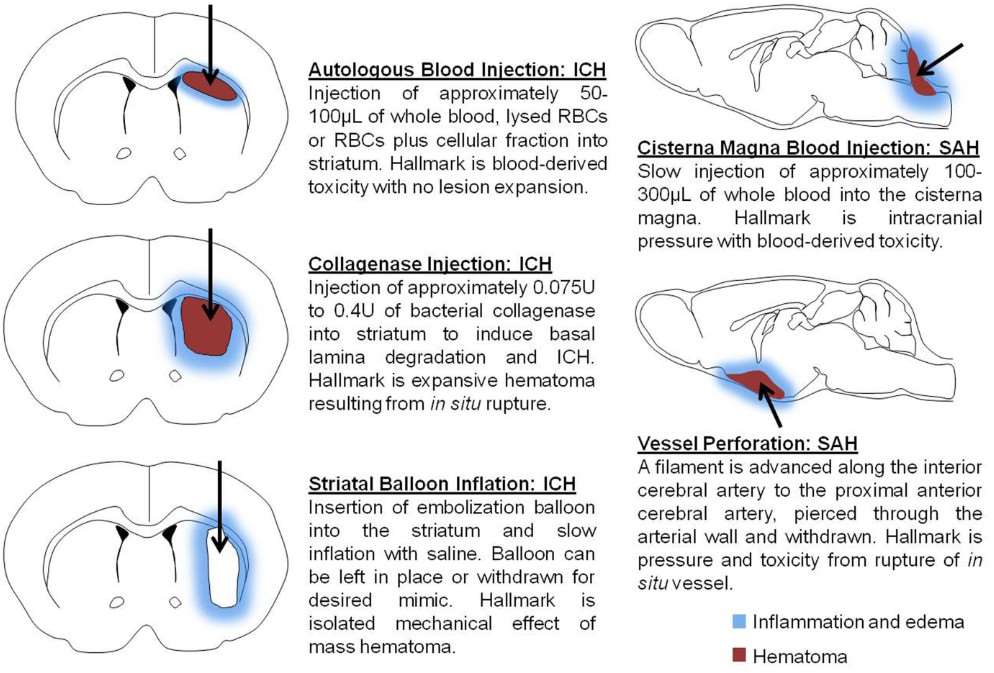- You are here: Home
- Disease Models
- Neurological Disease Models
- Intracerebral hemorrhage (ICH) Models
Disease Models
- Oncology Models
-
Inflammation & Autoimmune Disease Models
- Rheumatoid Arthritis Models
- Glomerulonephritis Models
- Multiple Sclerosis (MS) Models
- Ocular Inflammation Models
- Sjögren's Syndrome Model
- LPS-induced Acute Lung Injury Model
- Peritonitis Models
- Passive Cutaneous Anaphylaxis Model
- Delayed-Type Hypersensitivity (DTH) Models
- Inflammatory Bowel Disease Models
- Systemic Lupus Erythematosus Animal Models
- Asthma Model
- Sepsis Model
- Psoriasis Model
- Atopic Dermatitis (AD) Model
- Scleroderma Model
- Gouty Arthritis Model
- Carrageenan-Induced Air Pouch Synovitis Model
- Carrageenan-Induced Paw Edema Model
- Experimental Autoimmune Myasthenia Gravis (EAMG) Model
-
Cardiovascular Disease Models
- Surgical Models
- Animal Models of Hypertension
- Venous Thrombosis Model
- Atherosclerosis model
- Cardiac Arrhythmia Model
- Hyperlipoidemia Model
- Doxorubicin-induced Heart Failure Model
- Isoproterenol-induced Heart Failure Model
- Arterial Thrombosis Model
- Pulmonary Arterial Hypertension (PAH) Models
- Heart Failure with Preserved Ejection Fraction (HFpEF) Model
-
Neurological Disease Models
- Alzheimer's Disease Modeling and Assays
- Seizure Models
- Parkinson's Disease Models
- Ischemic Stroke Models
- Acute Spinal Cord Injury (ASCI) Model
- Traumatic Brain Injury (TBI) Model
- Hypoxic-Ischemic Encephalopathy (HIE) Model
- Tourette Syndrome (TS) Model
- Amyotrophic Lateral Sclerosis (ALS) Model
- Huntington's Disease (HD) Model
- Intracerebral hemorrhage (ICH) Models
- Pain Models
- Metabolic Disease Models
- Liver Disease Models
- Rare Disease Models
- Respiratory Disease Models
- Digestive Disease Models
-
Urology Disease Models
- Cisplatin-induced Nephrotoxicity Model
- Unilateral Ureteral Obstruction Model
- 5/6 Nephrectomy Model
- Renal Ischemia-Reperfusion Injury (RIRI) Model
- Diabetic Nephropathy (DN) Models
- Passive Heymann Nephritis (PHN) Model
- Adenine-Induced Chronic Kidney Disease (CKD) Model
- Kidney Stone Model
- Doxorubicin-Induced Nephropathy Model
- Orthopedic Disease Models
- Ocular Disease Models
- Skin Disease Models
- Infectious Disease Models
Intracerebral hemorrhage (ICH) Models
Creative Bioarray has successfully developed a series of sophisticated rodent models specifically designed to simulate intracerebral hemorrhage (ICH). These models are instrumental in conducting contract research studies aimed at evaluating the efficacy of innovative drug candidates. By offering tailored solutions, we support clients in advancing their understanding of ICH pathophysiology and in the development of novel treatments, ultimately contributing to improved patient care.
Stroke is a significant healthcare challenge, costing $73.7 billion annually in the U.S. and being the fourth leading cause of death. Particularly deadly are hemorrhagic strokes, which account for about 13% of cases and have a 30-40% mortality rate, with half of deaths occurring within 48 hours. These strokes occur due to blood leakage into the brain or subarachnoid space, often from hypertension, arteriovenous malformations, or head trauma. The critical need for effective treatments has made animal models essential for understanding injury mechanisms and identifying potential therapeutics. However, the frequent failure of candidate drugs in clinical trials underscores the urgent need for more accurate preclinical models that closely mimic human conditions.
Our Animal Models of Intracerebral hemorrhage (ICH)
- Autologous Blood-Induced Intracerebral Hemorrhage (ICH) Model
- Collagenase-Induced Intracerebral Hemorrhage (ICH) Model
 Fig. 1 Schematic depicts models commonly used to mimic intracerebral hemorrhage (ICH) and subarachnoid hemorrhage (SAH). (Leonardo et al. 2012)
Fig. 1 Schematic depicts models commonly used to mimic intracerebral hemorrhage (ICH) and subarachnoid hemorrhage (SAH). (Leonardo et al. 2012)
Quotation and Ordering
Creative Bioarray has a team of highly skilled scientists who specialize in pharmacology and efficacy studies. With a range of behavioral and analytical techniques, we can provide comprehensive and customized services with the highest quality and the most competitive prices for each project. If you are interested in our services, please feel free to contact us at any time or submit an inquiry to us directly.
Reference
- Leonardo, C.C., et al. Translating basic science research to clinical application: models and strategies for intracerebral hemorrhage. Frontiers in neurology, 2012, 3: 85.
For research use only. Not for any other purpose.

